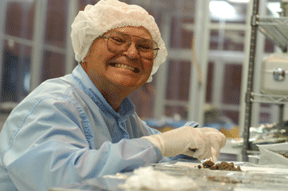 Genesis
Principal Investigator Donald Burnett was all smiles this
past holiday season thanks to Johnson Space Center's (JSC)
Curation team, delivering portions of the jolly ol' Sun
for analysis here on Earth. Genesis
Principal Investigator Donald Burnett was all smiles this
past holiday season thanks to Johnson Space Center's (JSC)
Curation team, delivering portions of the jolly ol' Sun
for analysis here on Earth.
Burnett received several 5-7 mm-sized wafer fragments,
as did Co-Investigators at JSC, early December 2004.
Co-Investigators at Washington University in St. Louis
received a cut piece of the Polished Aluminum Collector
on Jan. 4, 2005. This was the first delivery supporting
the "early science return" activity that will
establish solar isotopic and elemental abundances of
noble gases.
Burnett et al. will characterize the solar wind collector
surface contamination, evaluate the effectiveness of
existing cleaning techniques and identify new techniques.
Preliminary results indicate that surface contamination
of the wafers will be manageable for many analytical
techniques.
Characterization tools are Spectroscopic Ellipsometry
at JSC, X-ray Photoelectron Spectroscopy (XPS) at the
Jet Propulsion Laboratory and Secondary Ion Mass Spectrometry
(SIMS) at Charles Evans Associates.
One encouraging side result of the SIMS analysis was
the detection of implanted hydrogen, magnesium and iron
in the collector materials.
Scientists at UC Berkeley are also working with Genesis
flight samples, and science team members around the
world are calibrating their equipment, in anticipation
of the allocation of Genesis samples to the international
community.
But despite the early science return objective, curation
team members are deliberate and calculating with each
decision regarding the samples, and are in, "no
rush," as Project Scientist, Amy Jurewicz put it.
"The Genesis team still fully expects to meet
all of its science goals, but that will only happen
if the samples are cleaned, stored and analyzed properly,"
said Jurewicz. "Clearly this effort is a work in
progress and will be for some time."
Meticulous information on the contamination of the
spacecraft is being compiled by a collaboration of JSC's
curatorial staff, Genesis team members and NASA's sample
Curation and Analysis Planning Team for Extraterrestrial
Materials (CAPTEM). This collaboration is also experimenting
with cleaning techniques and planning for the future.
Detailed preliminary reports from these studies are
expected to be presented to the scientific community,
as well as the interested public this March, at the
Lunar and Planetary Science Conference.
As for Genesis's spacecraft bus, the last day of commanding
the spacecraft's primary mission was Dec. 2, 2004.
Shortly after 1 p.m. the Genesis flight team sent commands
to place the spacecraft into a hibernation mode. While
in this "safe" mode, it will continue transmitting
health and safety information, autonomously pointing
its solar arrays toward the Sun.
The spacecraft is on a trajectory to leave the Earth-Moon
Lagrange 1 (L1) vicinity going into a long-term heliocentric
orbit around the Sun, with Earth trailing behind. The
craft will be able to be maneuvered to stay in the Earth-Moon
vicinity up through Feb. 1, 2005.
Although the Genesis flight team bade farewell to its
spacecraft, it will not be forgotten. On a more personal
note, Burnett summed up the team's feelings about Genesis
when he said, "It's always hard to say goodbye
to a good friend."
|
